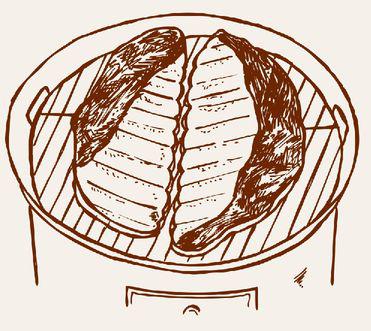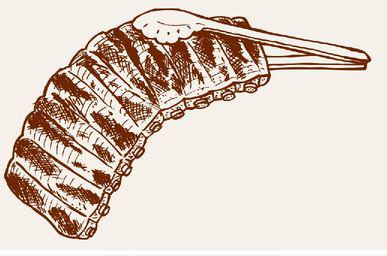Low & Slow: Master the Art of Barbecue in 5 Easy Lessons (23 page)
Read Low & Slow: Master the Art of Barbecue in 5 Easy Lessons Online
Authors: Colleen Rush,Gary Wiviott

BOOK: Low & Slow: Master the Art of Barbecue in 5 Easy Lessons
12.31Mb size Format: txt, pdf, ePub
Answers: 1) False. You should never buy enhanced ribs. 2) b. 3) Mustard helps the rub stick to the meat. 4) False. Shiners are ribs that have been trimmed too close to the bone, so that the bone shows through the meat. Buy meaty ribs with good marbling, but no large patches of fat. 5) d. Temperature fluctuations happen when the water pan or charcoal is low or the cooker is restocked with fresh, lit charcoal. 6) Because these sections are more resistant to higher temperatures and temperature fluctuations in the cooker. 7) c. 8) Ash blowing around in the cooker will stick to the meat, and sugar will burn if the temperature in the cooker gets too high.
6.
LESSON N°4 SPARE RIBS
RAISE YOUR RIGHT HAND, REACH IT OVER YOUR LEFT SHOULDER AND GIVE
yourself a hearty pat on the back. You’ve made it to Lesson #4, which means you are clearly made of sturdier stuff than was apparent when you started this program. Because you did complete Lessons #1 through #3, correct? You wouldn’t skip ahead to the second most difficult cook in the book because spare ribs are your favorite and you just couldn’t resist, would you? You’re far too smart to do something so dumb. Besides, the majority of this cook is very similar to Lessons #1 through #3. It requires the same charcoal and wood setup, and you’ll use all of the techniques and sharpened barbecue instincts you picked up in the other cooks to make these spare ribs. Without that base of knowledge, well . . . I’d rather not even think about the culinary disaster that awaits you if you skip a Lesson and attempt this cook.
yourself a hearty pat on the back. You’ve made it to Lesson #4, which means you are clearly made of sturdier stuff than was apparent when you started this program. Because you did complete Lessons #1 through #3, correct? You wouldn’t skip ahead to the second most difficult cook in the book because spare ribs are your favorite and you just couldn’t resist, would you? You’re far too smart to do something so dumb. Besides, the majority of this cook is very similar to Lessons #1 through #3. It requires the same charcoal and wood setup, and you’ll use all of the techniques and sharpened barbecue instincts you picked up in the other cooks to make these spare ribs. Without that base of knowledge, well . . . I’d rather not even think about the culinary disaster that awaits you if you skip a Lesson and attempt this cook.
The biggest difference in this cook is that spare ribs are meatier and tougher than any meat you’ve smoked so far on your cooker. Spare ribs are not as naturally tender as baby back ribs and will require a longer cook—four hours, at a minimum, on the offset and WSM. In some cases, depending on your cooker and such factors as the temperature outside, the wind, and the musculature of the piggy, it could take as long as six hours to complete this cook.
Because this cook is longer than the previous cooks, you will also begin to use the full potential of the fire you build. In Lessons #1 through #3, I noted several times that you would be burning up far more charcoal than was necessary for cooks on the WSM and offset, purely as a way of learning how long your cooker can go before the charcoal needs restocking to maintain the proper temperature. In Lesson #4, you’re actually using the right amount of charcoal for the amount of time you’ll be cooking. When it’s all over, you’ll see that the smoker—particularly the WSM—is capable of cooking for extended periods of time without much futzing.
Sadly, this knowledge and futz-free methodology does not apply to kettle users, particularly in the longer cooks. Because the kettle grill is reconfigured for indirect heat and, thus, has less surface area for charcoals and cooking, the charcoal requires constant maintenance. The kettle also cooks hotter and faster. You learned in Lesson # 3 to check the charcoal and water pan every thirty minutes to one hour and restock as needed. This cook is no different—it’s just a bigger piece of meat that requires more cooking time. As much as I love the kettle for grilling, the biggest downside to it is that these frequent checks are a must when the grill is set up for for low and slow. I’m willing to bet that if you complete this program, a WSM or offset will be on your very next birthday wish list.
As in the other Lessons, I’m also sharing a handful of my favorite barbecue rubs, sauces and marinades that are excellent on spare ribs, including the aptly-named and highly-acclaimed (by my friends, at least) Gary Wiviott’s Rub (page 160)—a blend I’ve kept secret, until now. Well, okay, I left out a secret ingredient or two. Even a barbecue life coach can’t reveal all of his tricks.
You’ll also be thrilled to find out I’m finally giving you permission to explore the full meat-cooking potential of your equipment with instructions on how to stuff your smoker (page 000). After you successfully complete Lesson #4, I hereby grant you permission to invite a friend or two over to sample your tasty, perfectly-cooked ribs.
Good luck, and may the pork be with you.
Sincerely,


Gary Wiviott
SPARE RIBS
Racks of spare ribs are bigger, tougher and fattier than baby back ribs, and the cook will be longer than any of the previous lessons. Because of the increased size, you may have to scrunch or fold the ends of the racks to fit the grate. You will also restock the charcoal and water—at least once on the WSM, and about every hour on the offset and kettle. Otherwise, this cook is like the others. There should be no surprises if you’ve successfully completed the first three Lessons.
WSM AND OFFSETSERVES 4 TO 62
(
4- to 6-pound) racks untrimmed spare ribs
2 cups white vinegar
½ cup prepared yellow mustard
Junior Rub (next page)
Tart Wash (page 115)
KETTLESERVES 2 TO 31 (3- to 5-pound) rack untrimmed spare ribs
1 cup white vinegar
¼ cup prepared yellow mustard
Junior Rub (next page)
Tart Wash (page 115)
6 TO 7 HOURS BEFORE DINNER
Set up and start a KISS Method fire according to the instructions for your WSM (page 32), offset (page 34), or kettle (page 36).
While you’re waiting for the charcoal in the chimney to engage, rinse the rib racks in the sink under cold water. Splash each rack with about 1 cup of vinegar and lightly rub the vinegar into both sides. Rinse the racks again under cold water. Set the ribs on a rimmed baking sheet and slather both sides with a light coating of yellow mustard, about ¼ cup per rack. Sprinkle about 2 tablespoons of rub over each rack, or more to taste.
TRIMMED VS. UNTRIMMED SPARE RIBSTHE INSTRUCTIONS AND TIMING
for the spare rib cook are based on untrimmed (tips-on) spare ribs. However, butchers in many stores trim spares “St. Louis–style,” with the tips removed. The presentation is neater, and the store can sell the rib tips separately. If you can only find St. Louis spares, keep in mind that the cooking times may decrease slightly, but hardly enough to worry about. Just use your instincts.
JUNIOR RUB
This easy blend is nearly identical to the Rudimentary Rub (page 115), with one addition: chipotle powder. It infuses the rub with a distinct smokiness and a little bit of heat without being spicy-hot.
MAKES ABOUT ½ CUP
3 tablespoons paprika
2 tablespoons freshly ground black pepper
1½ tablespoons kosher salt
2 teaspoons garlic powder
2 teaspoons onion powder
1 teaspoon chipotle powder or Toasted Mexican
Pepper Blend (page 18)
½ teaspoon cayenne pepper
2 tablespoons freshly ground black pepper
1½ tablespoons kosher salt
2 teaspoons garlic powder
2 teaspoons onion powder
1 teaspoon chipotle powder or Toasted Mexican
Pepper Blend (page 18)
½ teaspoon cayenne pepper
Combine all of the ingredients in a small bowl and whisk until the mixture is thoroughly blended.
After slathering a thin coating of yellow mustard on the ribs, sprinkle each rack with slightly more than 3 tablespoons of rub.
Store in an airtight container for up to two months.
INGREDIENT FINDER:
CHIPOTLE POWDERChipotles are smoked jalapeños, and the powder is made from toasted and finely ground dried chipotle peppers. This chile is to the new millennium what sun-dried tomatoes were to the nineties. When KFC is serving up chipotle fried chicken, you can pretty much assume it won’t be tough to find the powder. You can also make the powder by toasting and grinding dried chipotles, which may be easier to find in some rural locales.To make chipotle powder, stem and seed one dried chipotle. Tear the chipotle into small pieces. Toast the pieces in a hot skillet until fragrant, about five minutes. Allow the peppers to cool. Grind the toasted pepper in a coffee grinder or food processor until it is pulverized to a fine powder.
WSMWHEN THE LIT CHARCOAL
and wood are in place and ready for cooking, lay the racks on the top grate, meat-side down, bone-side up. Place the side of the rack with the angled “tip” section facing the outer edge of the WSM. If the racks are too long for the grate, scrunch them, like an accordion, to fit. Or roll the narrow end of the rack under. Set the lid on the cooker with the top vent facing the back side of the cooker, at about 1 o’clock from the door at 6 o’clock on the center ring.Set the oven thermometer on the grate.Check the vents. The top vent and the bottom three vents should be completely open.30 MINUTES INTO THE COOKClose the two bottom vents on the front side of the cooker by one-third. Remember, the top vent should always remain completely open and sit at about 1 o’clock from the door at 6 o’clock on the center ring. This ensures even airflow throughout the cooker.2½ HOURS INTO THE COOKRemove the lid, check the oven thermometer, and flip the ribs so the racks are meat-side up, bone-side down.Check the water pan. If it is less than three-quarters full, refill it to within 1 inch of the edge. For pointers, see Refilling the WSM water pan (page 38).4 HOURS INTO THE COOKCheck the water pan and the oven thermometer. If the pan is less than three-quarters full, refill it.Spritz each rack with about 2 tablespoons of Tart Wash.Use the tongs to check the ribs for doneness, holding the ribs one-third of the way into the rack to see if the rack flexes and cracks, as instructed for Lesson #3.The ribs will not be ready at this point, but doing the flex test here will illustrate the look and feel of the ribs at an early stage, for comparison with the later stages in the cook.4½ HOURS INTO THE COOKCheck the oven thermometer. Check the ribs for doneness again. Chances are the ribs will not be ready at this point, either. This check provides another reference point to gauge the changing appearance and texture of the ribs.Spritz the ribs with Tart Wash.5 HOURS INTO THE COOKCheck the oven thermometer.Check the ribs. The racks should be approaching the point where the meat around the ribs is starting to crack and break apart when you do the flex test with the tongs.If one rack is done, leave the other rack on the cooker (for comparison), meat-side up, and spritz with Tart Wash again. Check the water pan. If it is less than three-quarters full, refill it.If the rack isn’t done, check the ribs every 30 minutes until one rack is done, and refill the water pan as needed. It can take up to 6 hours to cook a big, meaty rack of spare ribs. You cannot go by the clock on this cook. You must use your barbecue instincts.Remove the second rack of ribs 30 minutes after you pull the first rack off of the cooker.
Other books
Cash (The Henchmen MC Book 2) by Jessica Gadziala
Ampersand Papers by Michael Innes
THE SPIDER-City of Doom by Norvell W. Page
The Throwaway Children by Diney Costeloe
The Pot Thief Who Studied Georgia O'Keeffe by J. Michael Orenduff
taboo3 takingthejob by Cheyenne McCray
An Experienced Mistress by Bryn Donovan
The Second Life of Samuel Tyne by Esi Edugyan
Friends With Partial Benefits by Luke Young
Black Dove by Steve Hockensmith


